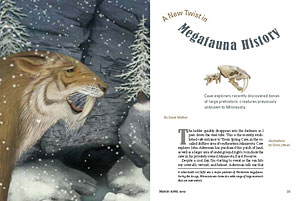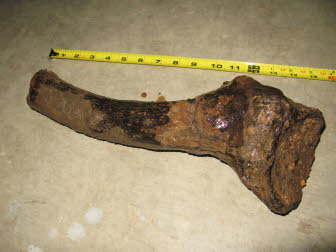![]()
|
A
new Twist in Megafauna History By David Mather |

The ladder quickly disappears into the darkness as I peer down the steel tube. This is the recently established safe entrance to Tyson Spring Cave, in the so-called driftless area of southeastern Minnesota. Cave explorer John Ackerman has purchased this patch of land, as well as a larger area of underground rights, to include the cave in his privately owned Minnesota Cave Preserve.
Despite a cool day, I'm starting to sweat as the sun hits my coveralls, wetsuit, and helmet. Ackerman tells me that it's 124 feet down to the cave floor. "You go first," he says, and I do.
My back bumps against the tube as I descend. My vision shrinks to the headlamp beam shining on my hands and the ladder rungs. My breathing echoes in my ears, but before long I can hear a trickle of water below. I pause to look up: The world I know is a tiny, white circle far above. A dozen rungs later, I step off the ladder and call up that I'm clear.
I stand on a gravel bar at the edge of an underground stream. The stream bends and falls, rushing over ledges and flowing through pools.
Ackerman soon joins me, followed by cave explorer Clay Kraus. We set off through the water, heading downstream. I stumble at times, uncertain of my footing. I wonder what I'm doing down here and then tell myself to shut up. I know the answer. I've come to see where the antler was found.
I first learned of Tyson Spring Cave several weeks before this visit. The explorers had found a large bone deep in the cave. Ackerman heard that I study animal bones and brought the specimen to my office at the Minnesota History Center. It was a thick section of antler, about 1.5 feet long, encrusted with mineralized sediment. A fragment of the skull was attached on one end. It definitely looked old, and I guessed it to be from an elk. But it was missing the classic lower tines of an elk antler.As I wrote a brief report of the find, I had some incredible Internet-age luck. Searching the Illinois State Museum Web site for elk finds across North America, I found an online exhibit about ice age animals, including the extinct stag-moose (Cervalces scotti). I clicked on the link and nearly fell off my chair when I saw a picture of a stag-moose skull: It looked like a good possibility for the fragment from Tyson Spring Cave. Later, paleontologists at the Illinois State Museum examined the fragment and confirmed that it came from an ancient animal, probably Cervalces or another extinct moose species.
Minnesota is not known for discoveries of Pleistocene megafauna because most of this land was then covered by glacial ice. But the driftless area was untouched by the most recent Wisconsin glaciation, which ended about 12,000 years ago. The region's deeply dissected karst topography is a truly ancient landscape.
Ice age Minnesota was a different world that slowly grew into the one we know today. A vast array of creatures disappeared shortly after the last glaciers melted. They once ruled the land, and the karst's limestone caverns and underground riverbeds might now hold a scientific treasure trove of their bones.
First of Its Kind
Skeletons of ice age animals are much better known from Kansas, Nebraska, and other states that were not covered by the most recent glacial advance. Rancho La Brea in Los Angeles is probably the most famous megafauna site in North America, and it holds the best samples of Smilodon. Closer to Minnesota, Pleistocene animal skeletons were found in an ancient sinkhole in Hot Springs, South Dakota. Both of those sites were natural traps. If the Tyson Spring bones came from a sinkhole as the explorers suspect, this cave could contain concentrations of ancient bones as well.
Pleistocene Boneyard
Despite the Pleistocene disadvantage of ice cover across most of Minnesota,
a number of megafauna finds had occurred in other places prior to the
ones at Tyson Spring Cave. A century ago the first director of the Geological
and Natural History Survey of Minnesota, Newton Winchell, published a
summary of discoveries known at that time. He described a mammoth tooth
found in glacial gravels along the Mississippi River at Wabasha. Surprisingly,
he also noted remains of ancient elephants found during early construction
work around Minnesota's towns and cities: Stillwater, Northfield, Minneapolis,
Minnetonka, Hastings, Mankato, and elsewhere. Bones of the extinct giant
beaver (Castoroides ohioensis) were unearthed in Minneapolis in 1879,
while a cistern was being dug at the corner of 15th and Washington avenues.
Winchell also described bones of musk oxen. These are not an extinct species,
but today they live in the arctic, far from Minnesota.
University of Minnesota geologist Clinton Stauffer presented the next summary of Minnesota megafauna in 1945, in the Proceedings of the Minnesota Academy of Science. He elaborated on some of the finds mentioned by Winchell, but the species list didn't change much. One addition was an ancient horse bone discovered 31 feet underground by a well driller in Marshall. Interestingly, Stauffer also mentioned a few discoveries of mammoth and mastodon from northern Minnesota -- near Brainerd, Chisholm, Deer River, Ball Club, and Grand Rapids. This was unexpected, because the north was covered by glaciers until around the time that most megafauna became extinct.
Across the Great Plains and Midwest, bison were the only species of ice age megafauna to survive the Pleistocene extinctions. The size of these ancient animals decreased throughout the past 12,000 years, culminating in much smaller modern bison. Ancient bison bones are not uncommon in Minnesota, often preserved in peat. A few of these finds are archaeological sites, where the animals were killed and butchered by people. The bison kill site in Itasca State Park is a scientific treasure itself, dating to about 8,000 years ago. The bog where the animals were trapped can be seen along Wilderness Drive. DNR archaeologist Dave Radford says that this is the only documented case of megafauna bones being found in Minnesota state parks.
Still Uncovering Mysteries
Bruce Erickson, chair of Paleontology at the Science Museum of Minnesota,
has firsthand knowledge of the megafauna relics in the museum's exhibits
and collection vaults. There are skulls of giant beavers and musk oxen.
A single claw from a giant ground sloth (Megalonyx jeffersoni) is incredibly
well-preserved, with its fragile outer sheath intact. Found in a peat
bog in the Twin Cities, the 9-inch-long claw belonged to a huge, lumbering
animal. It is Minnesota's only known sloth specimen.
One of the most complete skeletons of giant beaver known anywhere was found in St. Paul in 1938. A work crew was clearing away a collapsed shelf of Platteville limestone at Hidden Falls along the Mississippi and discovered the Castoroides skeleton along with bones from the modern species of beaver.
Erickson undertook a new analysis of this skeleton in the early 1960s, because the rare bones of the feet had not been properly described in earlier reports. Radiocarbon dating revealed that the beaver died about 10,300 years ago. The circumstances of the find indicate that Castoroides coexisted with modern beavers at that time. Erickson estimated that the animal might have weighed 250 pounds. It was not fully grown, as the ends of the longbones had not completely fused. Paleontologists suggest that an adult giant beaver would have been similar in size to a present-day black bear.
The Hidden Falls giant beaver is on display in the Mississippi River gallery at the Science Museum. It looks across at the Hollandale mammoth, the most complete woolly mammoth skeleton known from Minnesota. Downstairs in the paleontology laboratory, volunteers are removing the plaster field jackets from bones of the Lyle mammoth, a major discovery that is yet to be fully examined. These two mammoths were found relatively close to one another, in the vicinity of Albert Lea and Austin.
Back to the Cave
My headlamp goes out as I follow Ackerman and Kraus on our exit hike from
Tyson Spring Cave. Ackerman notices and trades helmets with me. The trip
back upstream doesn't seem nearly as long. I'm second up the ladder.
Wrestling my way out of the loaned caving gear in the sunlight, I laugh when Kraus emerges saying that he found another bone near the bottom of the ladder. But he's not kidding. The bone is small and stained black. It looks old. Its ends are rough, suggesting that the animal was young when it died. The shape is similar to a radius (forearm bone) from a large mammal, but it is tiny.
Small bones like this one hint at further possibilities that could fill out the picture of this ancient world. Widga has wondered if small bones found near the saber-tooth skull could be from saber-tooth kittens, although he stresses that more study is needed to determine if that's the case.
Tyson Spring Cave has produced two major discoveries -- two Minnesota firsts -- before an organized search has even begun. Just imagine what other discoveries might await.
| New discoveries Fillmore County's Tyson Spring Cave is one of several located within the privately owned Minnesota Cave Preserve. Nearly 175 bones have been unearthed at the preserve since the initial finds discussed in this story. Southeastern Minnesota's caves may hold a new chapter in what scientists know about Minnesota's natural history during the ice age. Though the region's caves are a promising area for future paleontological research, scientists must brave wet, dark conditions and take care not to damage the fragile geology. |
